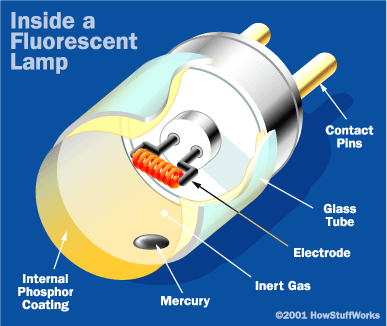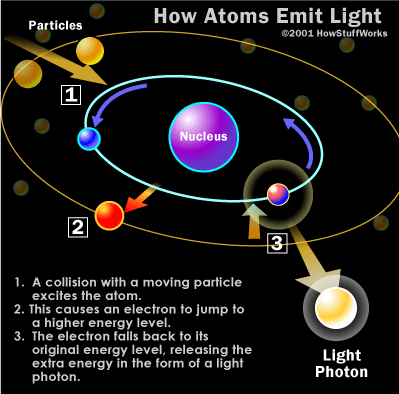What happens in the glass tube?
 The bulb is a glass tube filled with a halogen, usually argon, at a fraction of mean sea level pressure, as well as several milligrams of mercury. At either end is a filament with two leads. The inside surface of the glass is coated with a phosphor.
The bulb is a glass tube filled with a halogen, usually argon, at a fraction of mean sea level pressure, as well as several milligrams of mercury. At either end is a filament with two leads. The inside surface of the glass is coated with a phosphor.
There are two stages to understand, the starter kick and the continuous operation.
During the starter kick, current runs through the filaments individually, boiling off ions into the tube, which begins to ionize the argon. As the argon is heated, some of the mercury evaporates into the tube. Once the ionized gas is sufficiently conductive, the starter provides an extra kick of power as it turns off. Now electricity can flow through the tube between the filaments, and continuous operation can proceed.
How is the light created?
As electrons are flowing through the ionized gas, they will encounter the evaporated mercury. They will knock photons off the mercury atoms the same way it happens in an incandescent bulb. However, we don't yet have light, or rather, we have only ultraviolet light. To convert this light to the wavelength we want, we have coated the inside with a phosphor. When the UV light strikes the phosphor atoms, they give their energy to new photons of a visible wavelength. We can vary the color of the emitted light by selecting the types and concentrations of different phosphor coatings.
How are photons created?
 The electrons orbiting an atom are forced into orbitals of specific magnitude. They fit these orbitals because of principles similar to those of guitar string harmonics. When a particle collides with one such electron, it gains energy and is temporarily moved to a higher orbital. Then, when it falls back to its original orbital, it releases a photon. This manner of creating light is the same for the sun, the tungsten in an incandescent, and the mercury in a fluorescent bulb.
The electrons orbiting an atom are forced into orbitals of specific magnitude. They fit these orbitals because of principles similar to those of guitar string harmonics. When a particle collides with one such electron, it gains energy and is temporarily moved to a higher orbital. Then, when it falls back to its original orbital, it releases a photon. This manner of creating light is the same for the sun, the tungsten in an incandescent, and the mercury in a fluorescent bulb.
